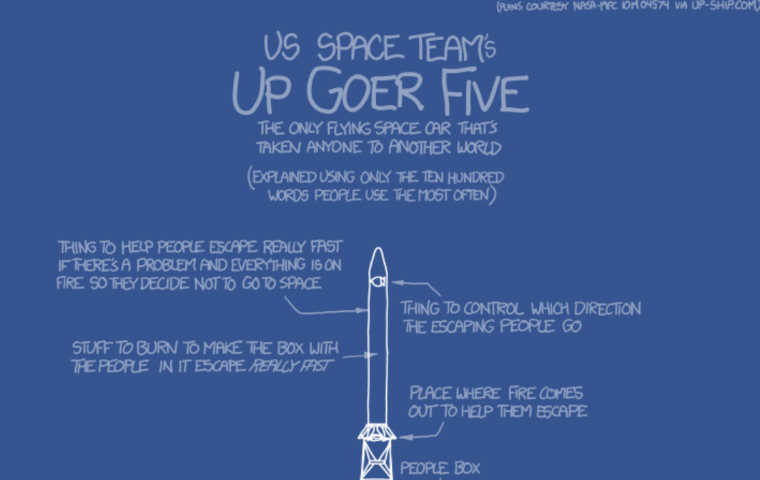
Et Tu Isotope?
Et Tu Isotope?
SCU environmental studies and sciences professor Hari Mix recently was asked to summarize his research on how nature and topography impact certain types of rainfall, to a roomful of students.
But there was a catch to this particular talk: he could use only words allowed by the scientific language-simplification tool known as UpGoer Five, which restricts users to the 1,000 most-used English words.
That’s hard to do for a presentation titled, “Evaluating the Roles of Topography and Aerosols in Atmospheric River Rainout Using a Paired Stable Isotope and Ice Nucleating Particle Time Series Approach.” In UpGoer speak, it sounded quite different: “Have you ever noticed how the person on TV doesn't always tell you when it will rain, or how much or where—or if it'll be rain or ice rain?” Mix said as part of his five-minute talk. “So, we need to learn how water trains in the sky work,” he said, using water trains as a substitute for “atmospheric rivers.”
UpGoer Five is a movement among scientists challenging them to convey their research as simply as possible, in much the same way that “design thinking” urges them to think of the end user before launching a new innovation.
“The point of UpGoer in an academic setting is to explain your research in a way that is accessible to a broad nonacademic audience,” said anthropology professor Michelle Bezanson, who organized an UpGoer event for the anthropology department last year. She argues that professors have an obligation to explain their work to the public in order to improve awareness, understanding, and appreciation of their research and how it is pertinent to people’s lives.
Another benefit? “The students really pay attention,” noted Prof. Virginia Matzek in her e-mail inviting a half-dozen Environmental Studies and Sciences Department and other faculty to present at the most recent session. “They are riveted by the language choices and trying to figure out the jargon-nonjargon equivalencies.”
UpGoer Five got its name from an online comic book that in 2012 impressively explained the Saturn V moon rocket using only a diagram annotated with words in the 1,000 most-used word list (up-goer was their word for the moon rocket). Scores of scientists subsequently latched onto the concept, and an online text editor was created to test one’s work against the allowable word list.
At the ESS event, Bezanson went for the abstract to explain her work, “Primatological Research in an Age of Extinction”—which examines whether researchers are having detrimental or unintended impacts on primates and their environments.
In UpGoer speak: “My work shows that crazy people like to study the same things that other crazy people study,” she said to surprised laughter at her choice of words to replace “researchers.”
“This will not help the other weird hair-covered large-brained animals live,” she continued. “Many are disappearing fast, but they are not the ones being studied. This is bad.”
Then there was environmental studies and sciences professor C.J. Gabbe, describing his paper on the impact of land-use regulations on housing stock in Los Angeles, which he dubbed the “big city by the water known for its movie stars.”
“There's not enough housing for all the people who want to live in the city,” he said. “And people who lead the city are trying to figure out how to get the people who build housing to build more of it in good places, like near train stops.”
Other professors who presented their research at the ESS event included ESS professors Iris Stewart-Frey and John Farnsworth, and civil engineering's Ed Maurer.
After the ESS event, the professors reflected on the challenge. Maurer, while expressing outrage that “isotope” wasn’t on the approved-word list, nonetheless said it was a good reminder to simplify.
“Communication is really where you get the payback for science,” he mused. “If you aren't communicating it to the broader society, then it's not going to have any influence.”
Gabbe added that it was nice to clear away jargon. “In urban planning there are so many words like “mixed use” and “transit-oriented development,” even “walkable” and “livable” and stuff,” he said. “Having to deconstruct what I was trying to mean, and tailor my findings for this limited palette of words was challenging, and kind of fun.”
Students in attendance enjoyed the exercise too, and understood how their own futures as scientists will include a need to be able to explain their work—be it to peers, funders, customers, or others.
“We all know kind of what their research is, and they are clearly trying not to dumb it down,” said senior Jack Williams. “It’s cool to see someone try to communicate that better—to know that a problem with a lot of science is it's not really communicate-able. It's something we're all going to have to do.”
Others liked the refreshing simplicity, and had a suggestion for their professors.
”If more classes were like this, or more professors were forced to use this kind of ideology,” said senior Travis Osland, “it would be really cool.”
The online comic book XKCD was the first to explain complex scientific concepts —in this case the Saturn V moon rocket—using only the 1,000 most popular words in English.